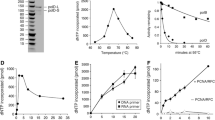Abstract
Thermoplasma acidophilum is a thermoacidophilic archaeon that grows optimally at pH1.8 and 56°C and has no cell wall. Plasmid pTA1 was found in some strains of the species. We sequenced plasmid pTA1 and analyzed the open reading frames (ORFs). pTA1 was found to be a circular DNA molecule of 15,723 bp. Eighteen ORFs were found; none of the gene products except ORF1 had sequence similarity to known proteins. ORF1 showed similarity to Cdc6, which is involved in genome-replication initiation in Eukarya and Archaea. T. acidophilum has two Cdc6 homologues in the genome. The homologue found in pTA1 is most similar to Tvo3, one of the three Cdc6 homologues found in the genome of Thermoplasma volcanium, among all of the Cdc6 family proteins. The phylogenetic analysis suggested that plasmid pTA1 is possibly originated from the chromosomal DNA of Thermoplasma.






Similar content being viewed by others
Abbreviations
- ORF:
-
Open reading frame
- Cdc6:
-
Cell division control protein 6
- RBS:
-
Ribosome binding site
- NCR:
-
Non coding region
- PKD:
-
Polycystic kidney disease
- TFIIB:
-
Transcription factor IIB
- BRE:
-
Transcription factor B recognition elemen
References
Brown JR, Doolittle WF (1997) Archaea and the prokaryote-to-eukaryote transition. Microbiol Mol Biol Rev 61:456–502
Brown JW, Daniels CJ, Reeve JN (1989) Gene structure, organization, and expression in archaebacteria. Crit Rev Microbiol 16:287–338
Capaldi SA, Berger JM (2004) Biochemical characterization of Cdc6/Orc1 binding to the replication origin of the euryarchaeon Methanothermobacter thermoautotrophicus. Nucleic Acids Res 32:4821–4832
Darland G, Brock TD, Samsonoff W, Conti SF (1970) A thermophilic, acidophilic mycoplasma isolated from a coal refuse pile. Science 170:1416–1418
Erauso G, Marsin S, Benbouzid-Rollet N, Baucher MF, Barbeyron T, Zivanovic Y, Prieur D, Forterre P (1996) Sequence of plasmid pGT5 from the archaeon Pyrococcus abyssi: evidence for rolling-circle replication in a hyperthermophile. J Bacteriol 178:3232–3237
Felsenstein J (1989) PHYLIP-Phylogeny Inference Package (Version 3.2). Cladistics 5:164–166
Giraldo R (2003) Common domains in the initiators of DNA replication in Bacteria, Archaea and Eukarya: combined structural, functional and phylogenetic perspectives. FEMS Microbiol Rev 26:533–554
Jones DT, Taylor WR, Thornton JM (1992) The rapid generation of mutation data matrices from protein sequences. Comput Appl Biosci 8:275–282
Kues U, Stahl U (1989) Replication of plasmids in gram-negative bacteria. Microbiol Rev 53:491–516
Liu J, Smith CL, DeRyckere D, DeAngelis K, Martin GS, Berger JM (2000) Structure and function of Cdc6/Cdc18: implications for origin recognition and checkpoint control. Mol Cell 6:637–648
Lopez P, Philippe H, Myllykallio H, Forterre P (1999) Identification of putative chromosomal origins of replication in Archaea. Mol Microbiol 32:883–886
Matsunaga F, Norais C, Forterre P, Myllykallio H (2003) Identification of short ‘eukaryotic’ Okazaki fragments synthesized from a prokaryotic replication origin. EMBO Rep 4:154–158
Mojica FJ, Ferrer C, Juez G, Rodriguez-Valera F (1995) Long stretches of short tandem repeats are present in the largest replicons of the Archaea Haloferax mediterranei and Haloferax volcanii and could be involved in replicon partitioning. Mol Microbiol 17:85–93
Ng WL, DasSarma S (1993) Minimal replication origin of the 200-kilobase Halobacterium plasmid pNRC100. J Bacteriol 175:4584–4596
Ree HK, Cao KM, Thurlow DL, Zimmermann RA (1989) The structure and organization of the 16S ribosomal RNA gene from the archaebacterium Thermoplasma acidophilum. Can J Microbiol 35:124–133
Reiter WD, Palm P, Zillig W (1988) Analysis of transcription in the archaebacterium Sulfolobus indicates that archaebacterial promoters are homologous to eukaryotic pol II promoters. Nucleic Acids Res 16:1–19
Robinson NP, Dionne I, Lundgren M, Marsh VL, Bernander R, Bell SD (2004) Identification of two origins of replication in the single chromosome of the archaeon Sulfolobus solfataricus. Cell 116:25–38
Ruepp A, Graml W, Santos-Martinez ML, Koretke KK, Volker C, Mewes HW, Frishman D, Stocker S, Lupas AN, Baumeister W (2000) The genome sequence of the thermoacidophilic scavenger Thermoplasma acidophilum. Nature 407:508–513
Sambrook J, Fritsch EF, Messing J (1989) Molecular cloning: a laboratory manual. Cold Spring Harbor Laboratory, Cold Spring Harbor
Schmidt HA, Strimmer K, Vingron M, von Haeseler A (2002) TREE-PUZZLE: maximum likelihood phylogenetic analysis using quartets and parallel computing. Bioinformatics 18:502–504
Searcy DG, Stein DB, Searcy KB (1981) A mycoplasma-like archaebacterium possibly related to the nucleus and cytoplasms of eukaryotic cells. Ann N Y Acad Sci 361:312–324
Singleton MR, Morales R, Grainge I, Cook N, Isupov MN, Wigley DB (2004) Conformational changes induced by nucleotide binding in Cdc6/ORC from Aeropyrum pernix. J Mol Biol 343:547–557
Thompson JD, Gibson TJ, Plewniak F, Jeanmougin F, Higgins DG (1997) The CLUSTAL_X windows interface: flexible strategies for multiple sequence alignment aided by quality analysis tools. Nucleic Acids Res 25:4876–4882
Woese CR, Kandler O, Wheelis ML (1990) Towards a natural system of organisms: proposal for the domains Archaea, Bacteria, and Eucarya. Proc Natl Acad Sci USA 87:4576–4579
Yasuda M, Yamagishi A, Oshima T (1995) The plasmids found in isolates of the acidothermophilic archaebacterium Thermoplasma acidophilum. FEMS Microbiol Lett 128:157–162
Author information
Authors and Affiliations
Corresponding author
Additional information
Communicated by F. Robb
Rights and permissions
About this article
Cite this article
Yamashiro, K., Yokobori, Si., Oshima, T. et al. Structural analysis of the plasmid pTA1 isolated from the thermoacidophilic archaeon Thermoplasma acidophilum . Extremophiles 10, 327–335 (2006). https://doi.org/10.1007/s00792-005-0502-z
Received:
Accepted:
Published:
Issue Date:
DOI: https://doi.org/10.1007/s00792-005-0502-z




